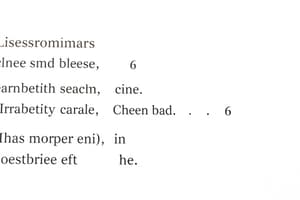Podcast
Questions and Answers
Which of the following sentences demonstrates the correct use of a reflexive pronoun?
Which of the following sentences demonstrates the correct use of a reflexive pronoun?
- He asked who was coming to the party.
- She bought herself a new car. (correct)
- They sent the package to them.
- We saw that the cat ate its food.
Identify the sentence in which the underlined word is functioning as an uncountable noun:
'The artist added more color to the painting.'
Identify the sentence in which the underlined word is functioning as an uncountable noun:
'The artist added more color to the painting.'
- I need three _eggs_ for the recipe.
- Several _ideas_ were proposed during the meeting.
- The value of _gold_ has increased recently. (correct)
- Can you hand me those _glasses_?
Which sentence contains a linking verb?
Which sentence contains a linking verb?
- The chef cooked the meal.
- He fixed the car.
- She seems happy. (correct)
- They ran quickly.
In the sentence, 'Running is her favorite activity,' which part of speech does the word 'Running' function as?
In the sentence, 'Running is her favorite activity,' which part of speech does the word 'Running' function as?
Identify the correct classification of the underlined pronoun in the following sentence: 'These are the books I was telling you about.'
Identify the correct classification of the underlined pronoun in the following sentence: 'These are the books I was telling you about.'
In which sentence does the verb express the perfect continuous aspect?
In which sentence does the verb express the perfect continuous aspect?
Which sentence contains an intransitive verb?
Which sentence contains an intransitive verb?
Choose the sentence that uses a proper noun correctly.
Choose the sentence that uses a proper noun correctly.
Which sentence demonstrates the correct use of a superlative adjective?
Which sentence demonstrates the correct use of a superlative adjective?
In which of the following sentences does the word 'nearby' function as an adverb?
In which of the following sentences does the word 'nearby' function as an adverb?
Identify the sentence that correctly uses a correlative conjunction.
Identify the sentence that correctly uses a correlative conjunction.
Which of the following sentences contains an interjection?
Which of the following sentences contains an interjection?
Select the sentence that demonstrates the correct use of the definite article 'the'.
Select the sentence that demonstrates the correct use of the definite article 'the'.
Which sentence correctly uses a preposition to indicate time?
Which sentence correctly uses a preposition to indicate time?
Identify the sentence where 'few' functions as a determiner correctly.
Identify the sentence where 'few' functions as a determiner correctly.
Which sentence contains an adjective used after a linking verb?
Which sentence contains an adjective used after a linking verb?
Determine which of the following sentences uses a subordinating conjunction to connect two clauses.
Determine which of the following sentences uses a subordinating conjunction to connect two clauses.
Which of the following options is NOT a determiner?
Which of the following options is NOT a determiner?
Flashcards
Parts of Speech
Parts of Speech
Words categorized by their function in a sentence.
Noun
Noun
Word representing a person, place, thing, or idea.
Proper Noun
Proper Noun
Specific noun (e.g., Paris, Shakespeare).
Pronoun
Pronoun
Signup and view all the flashcards
Possessive Pronoun
Possessive Pronoun
Signup and view all the flashcards
Verb
Verb
Signup and view all the flashcards
Transitive Verb
Transitive Verb
Signup and view all the flashcards
Auxiliary Verb
Auxiliary Verb
Signup and view all the flashcards
Regular Verbs
Regular Verbs
Signup and view all the flashcards
Irregular Verbs
Irregular Verbs
Signup and view all the flashcards
Adjective
Adjective
Signup and view all the flashcards
Preposition
Preposition
Signup and view all the flashcards
Conjunction
Conjunction
Signup and view all the flashcards
Interjection
Interjection
Signup and view all the flashcards
Articles
Articles
Signup and view all the flashcards
Determiners
Determiners
Signup and view all the flashcards
Coordinating conjunctions
Coordinating conjunctions
Signup and view all the flashcards
Study Notes
- Parts of speech, also known as word classes or grammatical categories, are fundamental to language, describing word function.
- Identifying parts of speech is crucial to understanding sentence structure and meaning.
- Traditional classifications include nouns, pronouns, verbs, adjectives, adverbs, prepositions, conjunctions, and interjections.
- Modern classifications can include articles, determiners, and other categories.
Noun
- A noun represents a person, place, thing, or idea.
- Concrete nouns include table and John, while abstract nouns include freedom and justice.
- Nouns can be singular or plural.
- Proper nouns (e.g., Paris, Shakespeare) refer to specific entities and are capitalized.
- Common nouns (e.g., city, writer) refer to general classes.
- Countable nouns (e.g., three books) can be quantified.
- Uncountable nouns (e.g., water, air) cannot be quantified.
- Nouns function as subjects, objects, complements, or appositives.
Pronoun
- A pronoun replaces a noun or noun phrase to avoid repetition.
- Personal pronouns refer to individuals or groups (e.g., I, you, he, she, it, we, they).
- Possessive pronouns indicate ownership (e.g., mine, yours, his, hers, its, ours, theirs).
- Reflexive pronouns refer back to the subject (e.g., myself, yourself, himself, herself, itself, ourselves, yourselves, themselves).
- Relative pronouns introduce relative clauses (e.g., who, whom, which, that).
- Demonstrative pronouns point to specific nouns (e.g., this, that, these, those).
- Indefinite pronouns refer to unspecified persons or things (e.g., someone, anyone, everyone, nobody).
- Interrogative pronouns introduce questions (e.g., who, whom, what, which, whose).
Verb
- A verb expresses an action, occurrence, or state of being.
- Verbs are the core of a sentence, indicating what the subject does or is.
- Transitive verbs take a direct object (e.g., She reads books).
- Intransitive verbs do not take a direct object (e.g., They sleep).
- Linking verbs connect the subject to a subject complement (e.g., He is a doctor).
- Auxiliary verbs (helping verbs) assist the main verb in expressing tense, mood, or voice (e.g., is, are, was, were, have, has, had, do, does, did).
- Verbs have different forms for tense (past, present, future), aspect (simple, continuous, perfect, perfect continuous), and mood (indicative, imperative, subjunctive).
- Regular verbs form the past tense and past participle by adding -ed (e.g., walk, walked).
- Irregular verbs have irregular forms (e.g., go, went, gone).
Adjective
- Adjectives modify nouns or pronouns, providing more information.
- Adjectives describe qualities like size, color, shape, and condition.
- Descriptive adjectives provide factual information (e.g., red car).
- Evaluative adjectives express opinions (e.g., beautiful painting).
- Adjectives typically precede the noun they modify (e.g., tall tree).
- Adjectives can appear after linking verbs (e.g., The tree is tall).
- Comparative adjectives compare two things (e.g., taller).
- Superlative adjectives compare three or more things (e.g., tallest).
- Articles (a, an, the) are sometimes classified as adjectives or determiners.
Adverb
- An adverb modifies a verb, adjective, or other adverb.
- Adverbs provide information about how, when, where, why, or to what extent.
- Adverbs of manner describe how an action is performed (e.g., She sings beautifully).
- Adverbs of time indicate when an action occurs (e.g., He arrived yesterday).
- Adverbs of place specify where an action takes place (e.g., They live nearby).
- Adverbs of frequency indicate how often an action occurs (e.g., I usually eat breakfast).
- Adverbs of degree indicate intensity (e.g., very, quite, extremely).
Preposition
- A preposition shows the relationship between a noun/pronoun and other words.
- Prepositions indicate location, direction, time, or manner.
- Common prepositions include: in, on, at, to, from, with, by, for, about, under, over, through, and between.
- Prepositional phrases have a preposition and its object (e.g., in the garden, on the table).
- The object of a preposition is usually a noun or pronoun.
Conjunction
- A conjunction connects words, phrases, or clauses.
- Coordinating conjunctions join equal grammatical ranks (e.g., and, but, or, nor, for, so, yet).
- Subordinating conjunctions introduce subordinate clauses (e.g., because, although, if, when, while, since, that).
- Correlative conjunctions connect equal elements in pairs (e.g., both...and, either...or, neither...nor, not only...but also).
Interjection
- An interjection expresses strong emotion or sudden feeling.
- Interjections are often independent, punctuated with an exclamation mark.
- Common interjections include: Oh, Ah, Ouch, Wow, Alas, Hey, and Yikes.
- Interjections lack grammatical relationships with other words in sentences.
Articles
- Articles are determiners specifying noun definiteness.
- "The" is definite, referring to a specific noun (e.g., the book).
- "A" and "an" are indefinite, referring to general nouns (e.g., a cat, an apple).
- "A" precedes words starting with a consonant sound.
- "An" precedes words starting with a vowel sound.
Determiners
- Determiners modify nouns by specifying quantity, definiteness, or possession.
- Articles (a, an, the) are determiners.
- Possessive pronouns (my, your, his, her, its, our, their) are determiners.
- Demonstrative pronouns (this, that, these, those) are determiners.
- Quantifiers (e.g., some, many, few, several, all, no) are determiners.
- Determiners are positioned before the noun they modify.
Studying That Suits You
Use AI to generate personalized quizzes and flashcards to suit your learning preferences.




